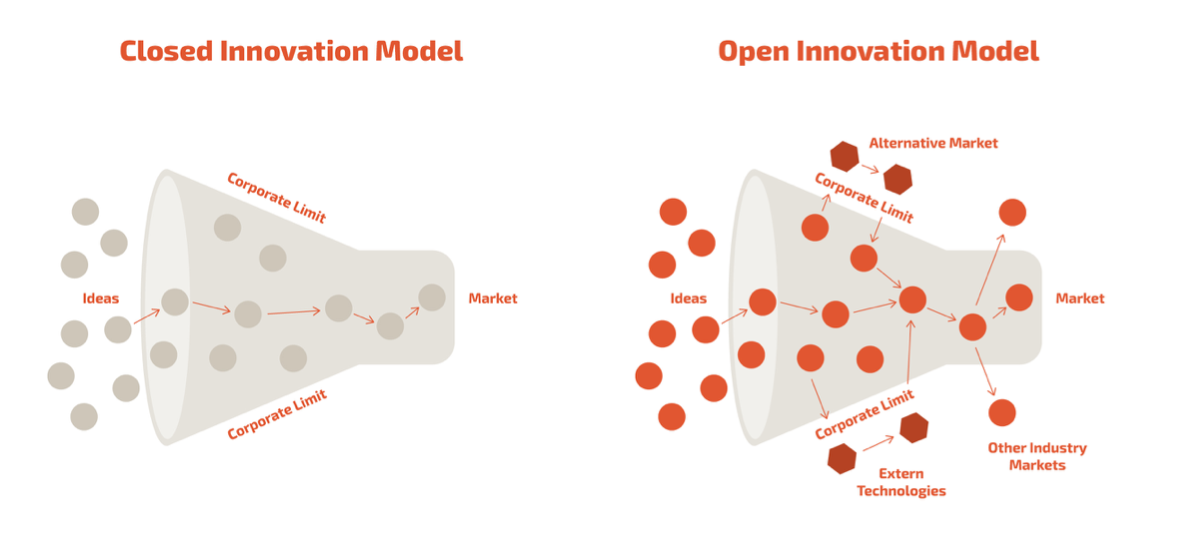Open Innovation vs. Closed Innovation
How to establish a resilient culture of open innovation and prevent closed innovation from returning unintentionally.

An open innovation approach is a good way for decision makers to improve the competitiveness of their company. To come up with new ideas, it makes sense in today's world to use the open innovation approach as a management tool. In addition to the advantages of an open approach to innovation, however, there are also risks.
This guide provides decision makers with an overview of:- The latest insights on open innovation.
- Tips for implementation.
- Notes regarding stumbling blocks.
Open innovation as a management tool
Open innovation is an approach that has become an important management tool in recent years. It is about bringing ideas and knowledge out of the company and involving external sources (ecosystems) such as customers, researchers, and partners. By accessing external ideas, companies can conquer new markets and improve their competitive advantage.
In the traditional understanding, the in-house R&D department is still in many cases perceived to be a separate unit which is the source of innovation. However, companies that are too focused on their internal capabilities overlook the need for an innovation strategy with open business models in times of ever shorter product life cycles, uncertain market demand, and rising R&D costs.
Effective implementation of open innovation requires open communication, productive collaboration, and a high level of commitment from all participants. The organization must provide the right support to drive the process and encourage all participants to share their ideas. At the same time, the organization should also be able to use external contributions effectively.
In addition, the culture of the company plays a decisive role in an open approach to innovation. C-level management have to set the example of open innovation themselves. They play an important role in institutionalizing an open approach to innovation. Otherwise, open innovation projects run in isolation and do not fit into the strategic portfolio. [3]
What distinguishes closed innovation from open innovation?
In innovation management, a distinction is drawn between the two paradigms of open innovation and closed innovation. Basically, they determine the way innovation is created. In closed innovation, an organization uses its own resources within the closed company environment. Open innovation, on the other hand, incorporates external knowledge into innovation management. [1]
One of the reasons why open innovation has advantages over closed innovation is explained by the Exponential Paradox.
What is the Exponential Paradox?
Technology is advancing at an accelerated rate, yet economic productivity growth is declining. Henry Chesbrough derives the need for open innovation from the Exponential Paradox, among other things: to fully exploit the potential of exponential technologies, the innovation process must be opened up. [4]
Open innovation versus closed innovation
Closed innovation is understood as vertical integration in which innovations are developed exclusively internally. However, the closed innovation approach is increasingly declining in significance due to costs, time, and risks.
This is where open innovation comes in. The open innovation model approach has been considered for some time as a solution to keep internal costs low, ensure faster time to market, and share risk.

Globalization and rapidly changing situations are in part forcing companies to open up their innovation processes. In some areas, it is difficult for decision-makers to avoid opening up their innovation management. This makes it all the more important to proactively move the organization toward open innovation. This makes it easier to control, for example, which types of open innovation are desired (more on this later).
What does open innovation mean?
The open innovation paradigm is therefore the polar opposite of the traditional model (closed innovation). No matter how effectively a company operates internally, the external knowledge networks and knowledge communities are relevant to the development of innovations.

The open innovation model is about external ideas and technologies being absorbed by the organization (outside-in open innovation) and unused internal ideas and technologies being externalized (inside-out open innovation). The basic prerequisite is a distributed innovation process with which internal and external knowledge can be used across organizational boundaries. [4]
What distinguishes distributed innovation from open innovation?
Open innovation is more than crowdsourcing or accelerator programs.
To commercialize the innovations, companies create business models and disseminate the innovation. For decision-makers, it is important to understand the difference between open and distributed/free innovation, especially in strategic projects. This means, for example, that a community is working on something new in the sense of an open source approach. The Linux open source project was initially worked on by Linus Torvalds and a small community of volunteers. This involves distributed innovation. Today, however, Linux is sustained by the participation of companies such as IBM, Google, Red Hat, and Amazon. The business models have evolved around Linux. Open source software has thus become an open innovation topic for companies. This also means that legal regulations and business models must be in place. [4]
Open innovation as a management tool offers companies many advantages: they benefit from the higher degree of openness, as a larger pool of knowledge and ideas is available and the innovation process can be accelerated. For this to succeed, divergent routines must be prevented and strategic goals set accordingly.
Advantages of an open approach to innovation
There are a number of studies suggesting open innovation has a positive influence on corporate performance. Examples of positive effects might be:
- Knowledge and competence gaps in one's own company can be closed by cross-border access to knowledge.
- When collaborating with partners, costs and risks can be shared.
- By opening up to the outside world, new technology markets can be identified more quickly.
- The competence of a learning organization is strengthened. The organization becomes more adaptive and resilient. [3]
Important: open innovation is not the outsourcing of innovation management. It is not a strategy for reducing investment in innovation.
Risks of corporate open innovation
The big challenge for established companies is often to incorporate external knowledge about the innovation process. The decision-makers must therefore be aware that the organizational competence must be established so that innovations are no (longer) created exclusively within the company. They take place in an interorganizational context. Absorptive capacity is needed for this. Through this absorptive capacity of an organization, the value of new information is better recognized, processed, and used. [9] If this absorptive capacity cannot be built up in the organization, there is a risk that open innovation will fail.
Tipping point of open innovation
The challenge for decision-makers is to find the optimal level of openness in innovation management for the organization. In research, there is also repeated talk of a tipping point when it comes to functioning open innovation. Lauser and Salter presented their findings on this in the "Strategic Management Journal 2006”, which point to an "optimal extent" of collaboration. Accordingly, there is a correlation between firms' openness to external search strategies and innovation performance.
Types of open innovation
Not all open innovation is the same. It encapsulates various forms and ways in which companies can collaborate with external stakeholders in innovation management or R&D. Basically, three types of open innovation processes can be distinguished:
- Inbound open innovation or outside-in process
- Outbound open innovation or inside-out process
- Coupled process

What is inbound open innovation?
If knowledge from external stakeholders is integrated into the company, this is referred to as inbound open innovation. In a so-called "outside-in" process, external knowledge is integrated, for example, through technology scouting, crowdsourcing, lead user conferences or cooperation with universities or start-ups.
Examples of inbound OI: Lego
Ideas and start-up competitions and crowdsourcing, such as Lego Ideas.
What is outbound open innovation?
In this "inside-out" process, intellectual property (IP) or technological knowledge is shared by the company with external parties. It's the riskier kind of open innovation.
Such an inside-out process can occur, for example, through out-licensing, joint development agreements, spin-offs, or incubator programs. Outbound open innovation is well suited for developing new business models within large companies. [4]
Example of outbound open innovation: Tesla
Elon Musk took the step at Tesla of making the patents for the drive technology publicly available. [2] With this move, he not only wanted to share knowledge with the industry, but also wanted Tesla's solution to become the dominant design in the industry. This is a risky move, which can of course also fail, as the competition takes development steps that can prevent such an undertaking.
What is a coupled open innovation process?
If both variants (inbound and outbound open innovation) are used in a company, this is referred to as a coupled process.
From coupled open innovation come strategies such as joint development, complementary partners through alliances and joint ventures.
Example: outside-in and inside-out open innovation in times of crisis
Looking back at the COVID pandemic, examples of both iterations can be found. The use of collaborative research – like to develop hand sanitizers – would be an example of an outside-in process. Making designs and intellectual property (e.g. for ventilators) publicly available to enable other manufacturers to produce similar goods is an example of inside-out processes. For example, in April 2020, Oxford University launched a partnership with biopharma company AstraZeneca to further develop and manufacture vaccines against COVID-19 on a large scale. [5]
Successful implementation of corporate open innovation: 3 valuable tips
If you want to implement open innovation in your company, you need to consider many aspects to ensure that an open innovation approach will actually be put into practice. These three tips will see you increase the chances of your project being successful:
- Nurture relationships: in corporate open innovation, relationships with external parties must be nurtured and managed. An open innovation culture requires a deep understanding of the needs and interests of all stakeholders in order to set the right priorities and solve problems.
- Question routines: decision-making processes need to be adapted to create room for innovative ideas and make decisions faster. Collaboration with external partners will most likely require a paradigm shift in processes and decision-making.
- Top-down and bottom-up: it needs the support of both managers and employees. Managers must instill confidence in innovative ideas, and employees must be given the necessary freedom in innovation projects.
If you take these three aspects into account when implementing corporate open innovation, you can be sure that your company will benefit from innovative ideas.
Slack policy example: Google und 3M
Many of Google's and 3M's breakthrough innovations were the result of a so-called "slack policy". In this process, project teams are given the freedom to spend 15–20% of their time developing "blue sky" ideas. The goal here is not for these ideas to find immediate application. A slack policy increases personal autonomy, reduces the not-invented-here syndrome, and allows ideas to be solicited from the outside. [3]
Open innovation and the management of intellectual property
One question that concerns decision-makers in connection with open innovation is how to deal with intellectual property rights. In the past, companies have accumulated intellectual property to give their employees more freedom and avoid expensive litigation. But not all patents prove valuable and are often never used. In the age of open innovation, companies should therefore make unused intellectual property available to others and at the same time search specifically for suitable intellectual property that opens up new business opportunities. This strategy allows companies not only to generate additional revenue, but also to expand into new business areas. A wise and forward-looking decision.
A clear definition of how to deal with intellectual property is what makes open innovation possible in the first place. It is a protection mechanism against direct imitation by other stakeholders. [4]
It is important to define the right degree of openness that leads to higher innovation performance while ensuring an appropriate level of permeability. Therefore, an open innovation concept should include protection mechanisms to prevent imitation attempts and opportunistic behavior. Clear collaboration with external partners enables employees to deal confidently with the topic of innovation and to represent it to customers or business partners.

At the same time, corporate open innovation must leave room to innovate discreetly on more confidential information and sensitive issues (e.g., regarding intellectual property). But there are approaches here, too, that do not contradict open innovation.
How do you prevent open innovation from failing in organizations?
- For knowledge sharing to take place, emphasize workforce training and provide the necessary latitude.
- Make it easy for employees to pick up ideas and develop them further.
- Clearly define how the results of externally acquired knowledge will feed into a company's subsequent innovation process.
- Encourage the dismantling of silo mentalities and take preventive measures so that defensive managers do not start hoarding ideas.
- Open Innovation does not replace an internal R&D department. Rather, you need to have an eye on ensuring that roles in the R&D department evolve in line with the open innovation strategy. [6]
Keep in mind that senior management's strategic intent must align with open innovation initiatives and outcomes. Otherwise, conflicting goals may arise and your team will work against the new innovation approach.
The not-invented-here and not-sold-here syndromes
If external ideas are rejected, this is referred to in innovation management as the not-invented-here syndrome (or NIH syndrome).
Less well known than NIH syndrome is not-sold-here syndrome (or NSH syndrome). If knowledge is passed on or ceded to external partners, the company's own employees may not be able to accept that market opportunities lie with another player. [3] When these syndromes occur, be mindful. Often they are the beginning of a reversal towards closed innovation.
When motivation and risk preferences lead managers in different directions, it makes it more difficult to institutionalize open innovation. CEOs and CTOs are often motivated by financial incentives (rewards) in the form of profit targets. In conjunction with an open innovation strategy, studies have demonstrated negative effects in this regard, such as those presented by Coff [7] in Strategic Management 2010. Maximizing shareholder value may create incentives for CTOs and CEOs that work against a company's open innovation strategy.
Decision-makers should be aware of the role they play in mitigating these risks. It is about reconciling divergent management motives with open innovation initiatives. You need to create the conditions under which managers make decisions that promote open innovation. [8]
When is the open innovation approach suitable for a company?
The way we create new ideas is as significant as the innovations themselves. Unfortunately, the current system leads to enormous resource waste and inefficiency. Making such potential (re)usable is a positive effect that open innovation can achieve. It is therefore essential to revise innovation models and find a more effective and collaborative method to drive progress. [5]
If your company is not able to manage innovation effectively, open innovation will not work. What helps is holistic innovation management.
Sources:
[1] Chesbrough H. (2003): Open Innovation: The New Imperative for Creating and Profiting from Technology.
[2] Tesla Pressemeldung (2014): All our patent are belong you.
[3] Shaikh I., Randhawa K. (2021): Managing the risks and motivations of technology managers in open innovation.
[4] Chesbrough H. (2020): Open Innovation Results: Going Beyond the Hype and Getting Down to Business.
[5] Liu Z., Shi Y., Yang B. (2022): Open Innovation in Times of Crisis: An Overview of the Healthcare Sector in Response to the COVID-19 Pandemic.
[6] Chesbrough H. & Brunswicker S. (2013): Managing open innovation in large firms und Chesbrough H. & Brunswicker S. (2015): A Fad or a Phenomenon? The Adoption of Open Innovation in Large Firms.
[7] Coff, R.W. (2010): The coevolution of rent appropriation and capability development.
[8] Arora, A., Belenzon, S., Patacconi, A. (2018). The decline of science in corporate R&D.
[9] Definition von Absorptive capacity in Wikipedia.











